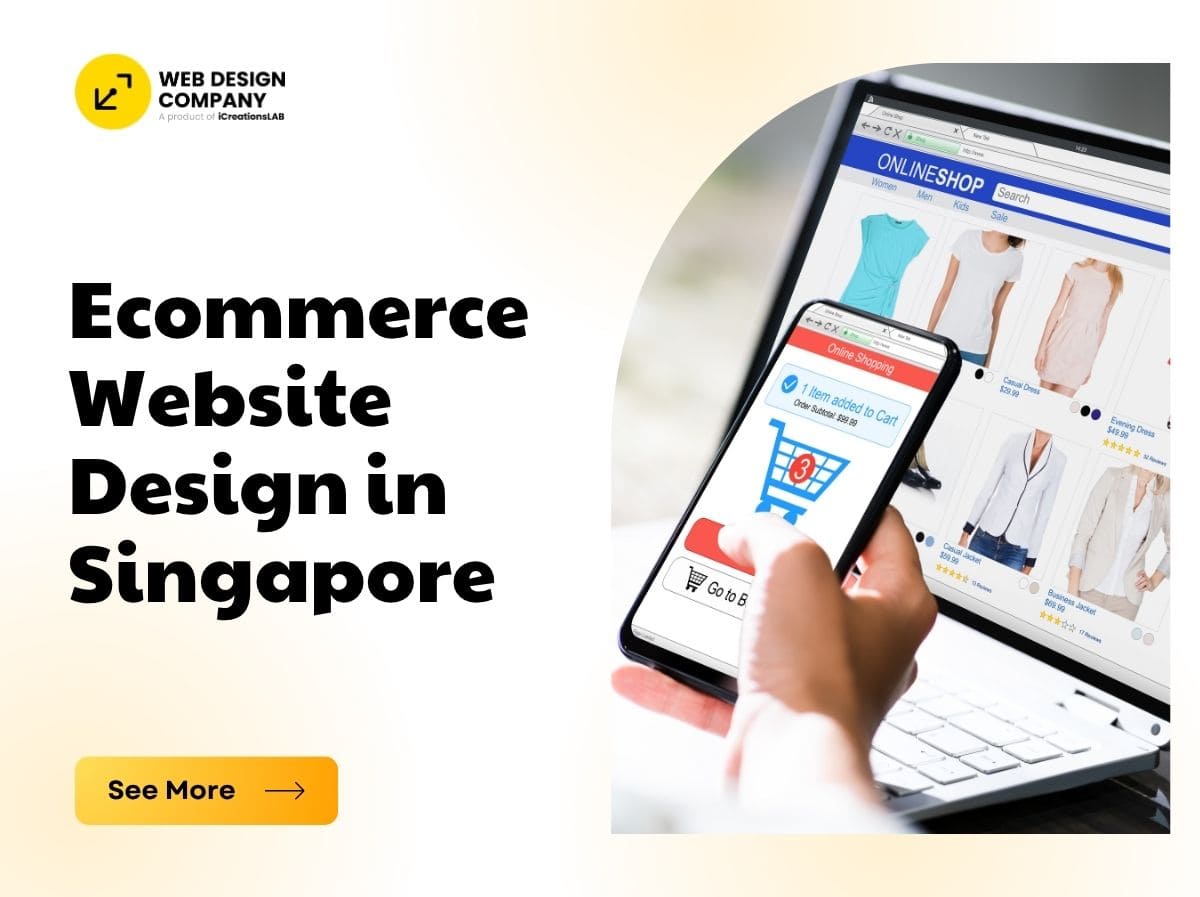
In the fast-paced digital economy of Singapore, ecommerce is booming. With more consumers shopping online than ever before, having a well-designed ecommerce website is no longer a luxury—it’s a necessity.
Whether you’re launching a new online store or planning to revamp your existing one, this guide will walk you through everything you need to know about ecommerce website design in Singapore. From essential features to local payment integration, SEO, mobile optimization, and costs—we’ve got you covered.
1. Why Ecommerce is Thriving in Singapore

Singapore is one of the most digitally connected countries in Asia. With high internet penetration, tech-savvy consumers, and robust infrastructure, the ecommerce market is projected to reach SGD 19.6 billion by 2027.
Key reasons why ecommerce is growing rapidly in Singapore:
- High smartphone and internet usage
- Government support for digitalisation (e.g., PSG grants)
- Growing trust in online payment systems
- Rising demand for convenience and fast delivery
This makes ecommerce website design Singapore a critical investment for businesses wanting to grow online.
2. Key Features of a High-Converting Ecommerce Website
Designing a successful ecommerce website involves more than just good visuals—it’s about creating a platform that works seamlessly and encourages users to take action. If you want to build an online store in Singapore that drives sales, your website must include the following essential features:
User-Friendly Interface
Your ecommerce site should be simple, intuitive, and easy to explore. Visitors should be able to find products, filter by categories, and access key information without confusion.
Key elements to include:
- Clear product categories and subcategories
- Search bar with filters (by price, brand, size, etc.)
- Prominent and well-designed call-to-action (CTA) buttons like “Add to Cart” or “Buy Now”
- Clean layout with a mobile-first design approach
A user-friendly layout helps reduce bounce rates and improves the overall shopping experience.
Mobile Responsiveness
In Singapore, more than 75% of online purchases are made on mobile devices. That means your ecommerce website must work perfectly on smartphones and tablets, not just desktops.
Best practices:
- Use responsive design that adjusts to different screen sizes
- Ensure fast mobile loading speeds (under 3 seconds)
- Use mobile-friendly menus like hamburger navigation
- Keep text and buttons large enough to tap easily
A mobile-optimized store ensures your business doesn’t lose potential customers on the go.
Secure and Smooth Checkout Process
One of the biggest reasons for cart abandonment is a complicated or untrusted checkout experience. Make your checkout process fast, simple, and secure to gain user confidence.
What to implement:
- SSL certificates to ensure data security (HTTPS URL)
- Display of security badges or trust seals
- Minimal checkout steps (1–2 pages max)
- Guest checkout option (no forced account creation)
- Auto-fill for shipping and billing details
The easier it is for a customer to check out, the higher your conversion rate.
Multiple Payment Options
Offering familiar and flexible payment options is key to gaining trust and completing sales in Singapore.
Recommended local payment gateways:
- PayNow – popular bank-linked instant transfer
- GrabPay – widely used digital wallet in Singapore
- Stripe Singapore – seamless card payment gateway
- Atome – “Buy Now, Pay Later” option for flexible payments
- eNETS or HitPay – trusted local payment processors for credit/debit cards
Catering to your customers’ preferred payment methods can dramatically reduce abandoned carts.
See More: Creative Web Design Agency in Singapore | iCreationsLab
Inventory & Order Management
Efficient back-end management is essential for delivering a smooth shopping experience and keeping your business running smoothly.
Use platforms that allow you to:
- Track stock levels in real-time
- Receive low inventory alerts
- Automatically update product availability
- Manage orders, shipping, and returns from a single dashboard
Popular ecommerce platforms like Shopify, WooCommerce, or Magento offer built-in inventory features or plugins to simplify the process.
Live Chat & Customer Support
Today’s shoppers expect instant answers. Integrating live chat into your ecommerce website helps improve user trust, solve problems quickly, and increase conversions.
Recommended tools:
- Tawk.to – free and easy-to-integrate live chat solution
- WhatsApp Business – allows real-time communication on a platform most Singaporeans already use
Live chat is especially important during peak shopping seasons or when offering high-ticket items that require pre-sale support.
By integrating these features, you’ll create an ecommerce website that’s not just attractive—but also functional, trustworthy, and conversion-focused. A well-built online store tailored to Singaporean consumer behavior gives you a significant competitive edge in the local market.
3. Choosing the Right Ecommerce Platform

One of the most important decisions you’ll make when building an online store is selecting the right ecommerce platform. This platform is the foundation of your website—it affects how your site looks, how easily it can be managed, and how well it performs.
There’s no one-size-fits-all solution. The right platform for your business depends on factors like your budget, technical expertise, business size, and future scalability needs.
Here’s a breakdown of the most popular ecommerce platforms used in Singapore:
Popular Ecommerce Platforms Compared
| Platform | Best For | Pros | Cons |
| Shopify | SMEs, startups, dropshipping | User-friendly, quick setup, reliable hosting | Monthly fees, limited design flexibility |
| WooCommerce | WordPress users | Fully customizable, open-source, large plugin library | Requires more technical setup and maintenance |
| Magento | Large businesses, enterprises | Extremely scalable, powerful features for complex stores | High development costs, needs skilled developers |
| Wix Ecommerce | Solopreneurs, small shops | Beginner-friendly drag-and-drop builder | Limited scalability for growing businesses |
| Shopcada | Local SMEs in Singapore | PSG grant-eligible, locally supported | Fewer third-party plugins than global platforms |
How to Choose the Right Platform
When evaluating ecommerce platforms, consider these important factors:
Ease of Use
- If you’re a beginner with no coding experience, platforms like Shopify or Wix Ecommerce are ideal.
- If you’re comfortable with WordPress, WooCommerce offers flexibility and control.
Customization Needs
- Want full control over your store’s functionality and design? Choose WooCommerce or Magento.
- Need a simple, fast solution? Go with Shopify or Shopcada.
Budget
- Shopify and Shopcada have monthly fees, but come with hosting, security, and support.
- WooCommerce and Magento are open-source, meaning the software is free—but you’ll need to budget for web hosting, themes, plugins, and developer support.
Scalability
- Planning to grow your product range or go regional? Choose a platform that can grow with you.
- Magento and WooCommerce are great for long-term scaling. Wix may not keep up as your store expands.
Local Support & Grants
If your business is based in Singapore, you may be eligible for the Productivity Solutions Grant (PSG)—a government subsidy that covers up to 50% of your ecommerce website development cost (as of 2025).
Platforms like Shopcada are pre-approved under PSG and tailored to meet local requirements, including GST compliance and integration with local payment gateways.
Pro Tip: Combine Platform Strengths
Some businesses use hybrid approaches. For example:
- Build the main website with WordPress + WooCommerce, and
- Use Shopify for product management or integration with social media shopping channels.
Summary
Choosing the right ecommerce platform is like choosing the right foundation for your house. It must fit your current needs but also support future growth.
If you’re a:
- Startup or SME → Start with Shopify or Shopcada
- Tech-savvy business owner → Consider WooCommerce
- Enterprise or large store → Look into Magento
- Solo entrepreneur → Try Wix Ecommerce
See More: Protect, Perform, Prosper: Why Your Website Needs Ongoing Maintenance
4. SEO for Ecommerce in Singapore: Be Found Online
Having a beautifully designed ecommerce website is great—but it won’t generate sales unless people can actually find it on search engines like Google Singapore. This is where SEO (Search Engine Optimization) plays a crucial role.
Effective ecommerce SEO helps your website appear higher in search results when potential customers search for products you offer. It brings free, organic traffic to your site and builds long-term visibility for your brand.
Here’s how to make your ecommerce website SEO-friendly and discoverable in Singapore:
Keyword Research: Target What People Are Searching
Before you start optimizing your site, you need to understand what your customers are typing into Google.
Use tools like Google Keyword Planner, Ahrefs, or Ubersuggest to find search terms that match your products and market.
Examples of ecommerce keywords in Singapore:
- “Buy skincare products Singapore”
- “Online store in Singapore”
- “[Product type] delivery Singapore”
- “Eco-friendly gifts Singapore”
Include both broad and long-tail keywords. Long-tail keywords (like “organic baby shampoo Singapore”) are less competitive and often have higher conversion rates.
On-Page SEO: Optimise Every Product Page
Each product page should be optimized so that search engines can understand what it’s about. This improves your chances of showing up in relevant search results.
Key on-page SEO techniques:
Add your main keywords to:
-
- Product titles (e.g., “Men’s Leather Wallet Singapore”)
- Meta descriptions (short summaries shown in Google search results)
- Headings (H1, H2, etc.)
- Product URLs (e.g., /products/mens-wallet-singapore)
Use high-quality images and include alt text that describes the image (e.g., “Red leather wallet with coin pocket”).
Write unique product descriptions that highlight the features and benefits. Avoid using generic or supplier-provided text that may be duplicated on other websites.
Local SEO: Target Singapore Shoppers
If your ecommerce business is based in Singapore or serves customers locally, local SEO helps you reach shoppers in your area.
See More: How Much Does Website Design Cost in Singapore?
How to improve your local search presence:
Set up and verify your Google Business Profile. This helps you appear in local results and Google Maps.
Use location-specific phrases throughout your site, such as:
-
- “Based in Singapore”
- “Ships islandwide”
- “Free delivery within Singapore”
Add your physical address and local phone number to your website footer and contact page—even if you don’t have a retail storefront. This adds credibility and improves local rankings.
Technical SEO: Ensure Fast, Clean, and Searchable Pages
Technical SEO involves the behind-the-scenes elements that help search engines crawl, understand, and index your website properly.
Important technical SEO steps:
- Make sure your website loads quickly, especially on mobile. Slow websites not only frustrate users but also rank lower on Google.
- Use a clean URL structure like /collections/men-shirts instead of long strings with random numbers or symbols.
- Implement schema markup (structured data) on product pages. This helps search engines display rich results like star ratings, price, and availability directly in search listings.
You can test your site’s performance and fix issues using tools like:
- Google PageSpeed Insights
- Lighthouse
- Ahrefs Site Audit
- Schema.org markup generator
Why Ecommerce SEO Matters in Singapore
Singapore’s ecommerce market is competitive. Relying only on paid ads (Google Ads or social media) can be expensive and short-term. SEO provides long-term value by driving organic traffic, reducing customer acquisition costs, and helping your site rank consistently.
A well-optimized ecommerce site ensures that:
- You appear in search results when shoppers are ready to buy
- You gain trust through strong visibility and brand presence
- You grow your business sustainably without depending entirely on ads
5. Design Considerations for Singaporean Shoppers

To succeed in ecommerce, it’s not enough to have a great-looking website—you must also understand your target audience’s behavior and preferences. In Singapore, online shoppers are tech-savvy, fast-moving, and value-conscious, so your ecommerce site should be designed with these traits in mind.
Below are key user expectations and design tips specifically tailored for Singaporean consumers:
🇸🇬 What Singaporean Shoppers Expect from an Ecommerce Website
a. Fast Loading Speed
Singaporeans are used to high-speed internet and have little patience for slow websites. If your pages take longer than 3 seconds to load, you risk losing potential buyers.
Tips:
- Use image compression tools (e.g., TinyPNG)
- Choose fast, local hosting or a global CDN (Content Delivery Network)
- Minimize scripts and third-party plugins
Why it matters: Speed affects both user experience and Google rankings.
b. Trust and Security
Shoppers in Singapore care deeply about safety when shopping online. To build confidence, your website must show clear trust signals.
Include the following elements:
- Customer reviews and star ratings
- Return and refund policies
- Secure checkout badges (SSL, McAfee Secure, Visa/Mastercard logos)
- Display of company UEN or business registration (if available)
Why it matters: Trust encourages first-time buyers and reduces cart abandonment.
See More: Spring Clean Your Website: The Complete Guide to Better UX & SEO
c. Mobile-Friendly & Convenient Navigation
Most users in Singapore shop from their smartphones, so your website must be designed for mobile-first navigation.
Key features to include:
- Sticky navigation bar or hamburger menu
- Easy-to-tap buttons and product filters
- Smart search bar with suggestions
- One-click access to cart, checkout, and support
Why it matters: The easier it is to find and buy products, the higher your conversion rate.
d. Localized Promotions & Discounts
Singaporean shoppers are price-conscious and love good deals. Highlighting local offers in SGD can improve engagement and urgency.
Promotion strategies that work:
- Display prices clearly in Singapore dollars (SGD)
- Use “Free Shipping Islandwide” labels
- Offer flash sales or “Today Only” countdowns
- Show “New Arrival” or “Best Seller” badges
Why it matters: Promotions tailored for local users increase conversions and customer loyalty.
e. Multilingual Support (When Needed)
While English is widely used in Singapore, offering content in Mandarin or Malay can expand your reach and make your store more inclusive—especially if you’re targeting older demographics or specific communities.
How to implement:
- Offer a language switcher at the top or footer of the site
- Translate core pages like Home, Product, and Checkout
- Use professional translation (avoid auto-translate for product pages)
Why it matters: Multilingual content improves accessibility and builds stronger customer relationships across cultural groups.
Summary: Localise Your Ecommerce Experience
When designing for Singaporean users, think fast, local, and trustworthy. A great ecommerce experience is not just about design—it’s about meeting the real expectations of your local audience.
By prioritizing:
- Fast performance
- Strong trust signals
- Seamless mobile experience
- SGD-based pricing
- Targeted promotions
- Optional language support
…you can turn casual visitors into loyal customers and thrive in Singapore’s competitive online market.
See More: Leveraging Local Cultural Nuance in Web Design
6. Legal, Tax, and Payment Compliance in Singapore
Running an ecommerce business in Singapore isn’t just about selling online—it also means complying with local legal, tax, and payment regulations. Ignoring these requirements can lead to penalties, loss of customer trust, and even legal trouble.
Here’s what every ecommerce business owner in Singapore needs to know:
Legal & Compliance Requirements
To operate lawfully and gain the trust of your customers, your ecommerce website must include certain legal information and documents.
Make sure to include the following on your website:
UEN (Unique Entity Number)
Display your business’s registered UEN to show legitimacy. This is especially important for B2B transactions or when working with government grants.
Registered Business Name
Clearly state your company’s legal name on the footer or About Us page. This helps build transparency and trust.
Legal Policies
You must publish the following pages on your website:
-
- Terms & Conditions: Defines how users can interact with your website and services.
- Privacy Policy: Explains how you collect, use, and protect personal data. This is a requirement under the PDPA.
- Return and Refund Policy: Outlines how customers can return products or request refunds.
These policies not only protect you legally but also increase consumer confidence—especially important in Singapore’s highly regulated digital space.
Complying With Singapore’s PDPA (Personal Data Protection Act)
The PDPA is a key regulation in Singapore that governs how businesses collect, use, and store personal data.
Your ecommerce site must:
- Obtain consent before collecting customer data (e.g., through signup forms or cookies).
- Securely store customer information using encrypted systems.
- Clearly explain your data handling practices in your Privacy Policy.
- Allow users to withdraw consent or request deletion of their data.
Non-compliance with PDPA can result in hefty fines from the Personal Data Protection Commission (PDPC), so it’s crucial to stay updated and follow best practices.
GST & Payment Processing Requirements
If your ecommerce business is growing, you also need to consider tax compliance—particularly GST (Goods and Services Tax).
When Do You Need to Register for GST?
If your business earns more than SGD 1 million in annual taxable turnover, you are legally required to:
- Register for GST with IRAS (Inland Revenue Authority of Singapore).
- Charge 9% GST (as of 2025) on your goods or services.
- File regular GST returns and keep detailed transaction records.
GST-Compliant Invoicing
Your ecommerce system should be able to:
- Issue invoices that show GST breakdowns
- Track and report taxable and non-taxable sales
- Integrate with accounting software like Xero or QuickBooks for seamless compliance
Platforms like Shopify, WooCommerce, and Shopcada support GST tracking and can generate compliant receipts with the right configuration or plugins.
Additional Payment Compliance Tips
To build customer trust and operate smoothly:
- Work with MAS-regulated payment gateways like Stripe Singapore, HitPay, or eNETS.
- Provide secure checkout with SSL encryption.
- Display logos of payment options (Visa, Mastercard, PayNow) to assure customers.
- If offering Buy Now Pay Later (BNPL) options like Atome or GrabPay Later, ensure clear disclosure of installment terms.
Summary: Stay Legal and Professional
Complying with local ecommerce laws not only protects your business but also gives customers confidence to buy from you. In Singapore, trust and credibility are key factors in online shopping decisions.
To ensure full compliance:
- Display your business registration and policies clearly
- Respect privacy laws under PDPA
- Meet GST obligations if eligible
- Use trustworthy, secure payment methods
By getting your legal and tax foundations right, you’ll set up your ecommerce store for sustainable and scalable success.
See More: What Is a Website? A Beginner’s Guide
7. Cost of Ecommerce Website Design in Singapore (2025)

When planning to build an ecommerce website in Singapore, understanding the cost involved is essential. Prices can vary significantly depending on the platform you choose, the complexity of features, the size of your product catalog, and whether you work with a professional agency or build it yourself.
Let’s break down the estimated costs and the key factors that influence them:
Estimated Cost Ranges (in SGD)
| Type of Ecommerce Website | Estimated Cost (SGD) |
| Basic Shopify Store | $2,000 – $4,000 |
| Mid-Tier WooCommerce Site | $4,000 – $8,000 |
| Custom Magento Website | $10,000 – $30,000+ |
| PSG-Subsidized Packages | From $1,500 (after Productivity Solutions Grant) |
Note: These estimates are based on 2025 pricing trends for ecommerce development in Singapore and may vary by agency or service provider.
What Influences the Cost of Ecommerce Website Design?
Several components contribute to the overall cost of developing an ecommerce site. Understanding these can help you budget effectively and avoid unexpected expenses.
a. Number of Product Pages
- The more products you list, the more time and effort are needed to design, organize, and upload them.
- Product variants (sizes, colors) and custom product filtering options also add complexity.
More products = more cost.
b. Custom Design vs. Template
- Template-based designs (like those offered by Shopify or Wix) are faster and cheaper to launch.
- Custom designs give you complete control over branding, layout, and UX but require more time and development work.
Templates save money. Custom designs build a stronger brand.
c. Advanced Features & Functionalities
Extra features enhance the customer experience but also increase the cost. Common add-ons include:
- Subscription systems (for recurring orders)
- Loyalty and rewards programs
- Live chat integration
- Wishlist or “Save for Later” features
- Multi-currency and multi-language support
- Custom checkout workflows
Each feature requires configuration or custom coding.
d. Third-Party Integrations
Many ecommerce businesses need to integrate their websites with tools like:
- CRM systems (e.g., HubSpot, Zoho)
- ERP platforms for inventory and finance
- Marketing tools (email automation, SMS alerts)
- Accounting software (e.g., Xero)
Integration complexity will raise the development cost, especially if custom APIs or plugins are required.
e. SEO & Content Writing Services
An ecommerce website isn’t complete without strong content. Many businesses hire experts to:
- Write compelling product descriptions
- Optimize pages for search engines (SEO)
- Create blog posts and guides to drive organic traffic
If you’re targeting high visibility in Singapore’s competitive online market, SEO and content marketing are long-term investments worth considering.
Tip: Consider PSG-Eligible Packages
The Productivity Solutions Grant (PSG) by the Singapore government can subsidize up to 50% of your ecommerce website cost, if you choose a pre-approved vendor.
Example:
A PSG-eligible ecommerce website package costing $3,000 may cost only $1,500 after subsidy—making it ideal for SMEs and startups looking to go digital.
To qualify:
- Your business must be registered and operating in Singapore.
- You must not have already signed the contract or paid the vendor.
- The vendor must be PSG-approved.
You can check eligibility on GoBusiness Singapore.
Summary: Plan Your Budget Wisely
Building an ecommerce website in Singapore can range from a few thousand dollars to tens of thousands, depending on your goals. By clearly defining your requirements and working with the right partner, you can get a site that fits your needs, timeline, and budget.
Key Takeaways:
- Start small with a template-based Shopify store if you’re on a budget.
- Invest in custom features and integrations as your business scales.
- Take advantage of government grants like PSG to reduce upfront costs.
- Don’t forget to budget for ongoing maintenance, marketing, and updates.
8. Ecommerce Marketing Essentials
Launching your ecommerce website is just the beginning—now you need to attract traffic, generate leads, and convert visitors into customers. In Singapore’s competitive digital landscape, having a smart and well-rounded marketing strategy is essential for success.
Here’s a breakdown of effective ecommerce marketing strategies that can help you grow your online store in Singapore:
a. Paid Advertising (PPC)
Paid ads allow you to immediately reach your target audience on the platforms they use most. They’re especially useful when launching new products or scaling quickly.
Top platforms for ecommerce ads in Singapore:
- Google Ads (Search & Shopping):
Appear at the top of Google when users search for specific products (e.g., “Buy wireless earbuds Singapore”). Google Shopping ads also show product images, prices, and links directly in search results. - Facebook & Instagram Ads:
Great for visual storytelling, retargeting, and reaching users based on interests and demographics. Ideal for fashion, beauty, home, and lifestyle products. - TikTok Ads:
Effective for trending and visually appealing products. TikTok’s younger demographic is highly engaged and responsive to creative, short-form videos.
Tip: Always start with a small budget and test multiple creatives and audiences before scaling.
b. Email Marketing
Email remains one of the highest-ROI marketing channels for ecommerce. With the right automation, you can build relationships, recover lost sales, and drive repeat purchases.
Popular email platforms:
- Mailchimp – beginner-friendly with ecommerce templates
- Klaviyo – ideal for Shopify and WooCommerce integrations
Email flows to set up:
- Welcome Series: Greet new subscribers with a discount or intro about your brand
- Abandoned Cart Reminders: Nudge users who left items in their cart
- Weekly Promotions: Share time-sensitive deals, bundles, or seasonal offers
- Product Launches: Announce new arrivals or restocks to your email list
Tip: Always comply with Singapore’s Spam Control Act by gaining consent before sending marketing emails.
c. Social Media Integration
Social media isn’t just for brand awareness—it can directly drive sales if properly integrated with your ecommerce store.
Steps to integrate your store with social platforms:
- Facebook Shop & Instagram Shopping:
Sync your product catalog so users can browse and purchase directly from your social pages. - Instagram Tags:
Tag products in your posts and stories, leading users straight to your product pages. - User-Generated Content (UGC):
Repost photos or reviews from your customers to build social proof and engagement.
Tip: Consistency is key. Post regularly, engage with followers, and use hashtags like #SingaporeShopping or #SGDeals to reach local audiences.
d. Marketplace Integration (Omnichannel Selling)
Many Singaporeans also shop on local marketplaces like Shopee, Lazada, and Qoo10. Instead of treating them as competition, consider integrating them into your sales strategy.
Benefits of marketplace sync:
- Reach a broader audience without building a separate store
- Avoid managing multiple inventories manually
- Use tools or plugins to sync inventory, prices, and orders across platforms
Popular tools for integration:
- SiteGiant
- EasyStore
- OmniChannel (Shopify & WooCommerce plugins)
Tip: Use marketplaces for high-volume sales and your own website for brand storytelling, loyalty programs, and higher-margin products.
Summary: Build a Full-Funnel Marketing Strategy
A successful ecommerce marketing plan includes awareness, engagement, and conversion tactics. By combining paid ads, email automation, social commerce, and marketplace integration, you can reach customers at every stage of the buying journey.
Here’s a simplified flow:
- Use Google and social ads to attract new visitors
- Capture emails with popups or offers
- Send automated emails to follow up or recover carts
- Drive engagement with Instagram Shopping and TikTok
- Expand reach via Shopee or Lazada integrations
9. Maintaining & Scaling Your Ecommerce Site
Launching your ecommerce website is a major milestone—but true success comes after the launch. To keep your store competitive, profitable, and scalable in Singapore’s dynamic market, you must actively manage and continuously improve your online store.
Here’s how to maintain and grow your ecommerce website over time:
Ongoing Website Maintenance
Maintaining your site regularly ensures smooth performance, fresh content, and an optimal user experience.
Key maintenance tasks:
- Update product listings: Add new items, remove discontinued ones, and refresh product images and descriptions.
- Promotions and pricing: Adjust pricing, highlight seasonal sales, and feature time-sensitive offers to stay relevant.
- Monitor site performance: Use tools like Google Analytics, GA4, and Hotjar to track visitor behavior, bounce rates, and conversion paths.
- Check site speed and functionality: Regularly test for broken links, outdated plugins, and mobile responsiveness.
Why it matters: A stale or glitchy site damages credibility and can result in lost sales.
Data-Driven Growth: Use Analytics to Scale
Data gives you insight into what’s working and what’s not. Use it to guide decisions and optimise performance.
What to track:
- Sales trends: Which products are top sellers? Which campaigns convert best?
- User behavior: What pages do users visit most? Where do they drop off?
- Conversion rate: Monitor how many visitors complete a purchase and find ways to improve it.
Tools to use:
- Google Analytics 4
- Meta Pixel
- Shopify/WooCommerce dashboards
- Heatmaps & session replays
A/B Testing & UX Optimisation
Test different elements on your site to see what drives better results. This can help boost conversions without increasing ad spend.
What to A/B test:
- CTA button text and placement
- Product image styles
- Pricing formats (e.g., $49 vs. $49.00)
- Page layout or checkout steps
Why it works: Small design tweaks can significantly increase your sales if based on real user behavior.
Boost Average Order Value (AOV)
Instead of only focusing on traffic growth, maximise the value of each customer by implementing smart upselling tactics.
Ways to increase AOV:
- Upsells: Suggest premium versions of a product during checkout
- Bundles: Offer related items as a discounted set
- Loyalty programs: Reward repeat customers with points or store credit
- Free shipping thresholds: Encourage larger orders by offering free delivery above a certain amount
Collect and Act on Customer Feedback
Customer insights help improve your offerings, fix pain points, and strengthen brand loyalty.
How to gather feedback:
- Post-purchase surveys
- Product review requests
- Live chat transcripts
- Social media engagement
What to do with feedback: Identify common issues, update FAQs, and prioritise feature or UX improvements that customers request.
Long-Term Growth Strategies
If you’re serious about scaling your ecommerce business, consider expanding beyond Singapore and tapping into regional or global markets.
Scalable growth options:
- Regional expansion: Target nearby markets like Malaysia, Indonesia, or the Philippines, especially if your logistics and pricing model allows.
- Local influencer marketing: Partner with Singapore-based influencers or content creators to reach niche audiences and build trust.
- Subscription models: Offer recurring delivery for products like skincare, pet supplies, or supplements to generate predictable revenue.
- Membership programs: Give customers access to exclusive products, discounts, or early access in exchange for a monthly fee.
